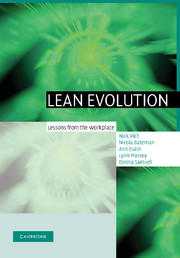Book contents
- Frontmatter
- Contents
- List of boxes
- List of figures
- List of tables
- Glossary
- 1 Introduction
- 2 Understanding the lean journey
- 3 Understanding your organisation
- 4 Laying the foundation stone of CANDO
- 5 Visual management and performance measurement
- 6 Problem solving, TQM and Six Sigma
- 7 Pull systems
- 8 Total productive manufacturing (TPM)
- 9 Sustainability
- 10 Group learning
- 11 Reflections and future challenges
- References
- Index
3 - Understanding your organisation
Published online by Cambridge University Press: 17 August 2009
- Frontmatter
- Contents
- List of boxes
- List of figures
- List of tables
- Glossary
- 1 Introduction
- 2 Understanding the lean journey
- 3 Understanding your organisation
- 4 Laying the foundation stone of CANDO
- 5 Visual management and performance measurement
- 6 Problem solving, TQM and Six Sigma
- 7 Pull systems
- 8 Total productive manufacturing (TPM)
- 9 Sustainability
- 10 Group learning
- 11 Reflections and future challenges
- References
- Index
Summary
Introduction
Working for a lean business has many advantages and attractions for every employee. Posing the question, ‘what's in it for me?’ reveals some interesting answers.
For business directors, the lean business offers a working environment within which there is lots of factual information about the business and its processes together with time, free from ‘fire-fighting’, to plan the future direction of the business. In the context of the traditional factory, managers are surrounded by ‘noise’, constant interruptions and chaos. This is not suited to effective thinking and ‘direction setting’ for the businesses (Dimancescu, 1992).
For middle managers, those who control business departments, lean benefits include working with other managers in groups to improve business processes in a more meaningful manner. This interaction is priceless and improves every managers' understanding of how the business works and of the pressures faced by each department. It is the time spent team working and the decisions of this management group which yield the largest of business improvements and financial savings.
For the operations teams, the lean environment creates stability and discipline within the workplace. It makes work more interesting and there is a lot more emphasis on Improvement, Development, Engagement and Autonomy (IDEA).
What has just been described cannot be achieved by an individual, it cannot be achieved quickly but it must be the goal of all lean businesses. For too many businesses though, what we have just described is somewhat distanced from current factory life.
- Type
- Chapter
- Information
- Lean EvolutionLessons from the Workplace, pp. 32 - 59Publisher: Cambridge University PressPrint publication year: 2006



